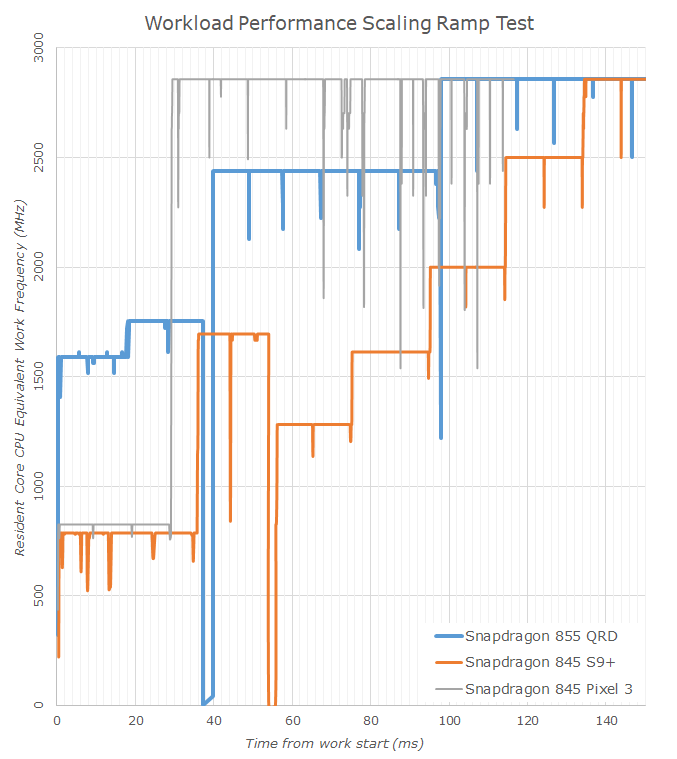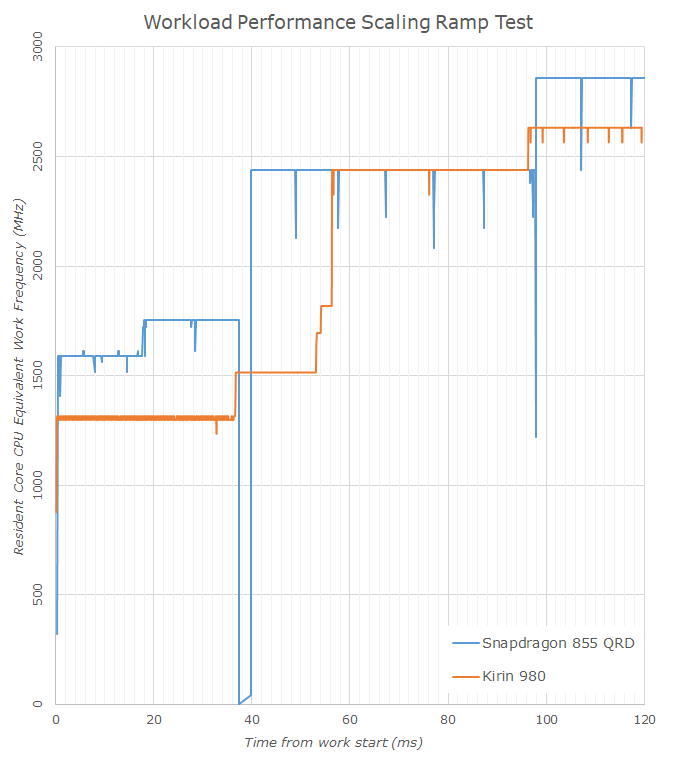The Snapdragon 855 Performance Preview: Setting the Stage for Flagship Android 2019
by Andrei Frumusanu on January 15, 2019 8:00 AM EST- Posted in
- Mobile
- Qualcomm
- Smartphones
- SoCs
- 7nm
- Snapdragon 855
System Performance - Slightly Underwhelming?
While synthetic steady state workloads are one thing, real-world workloads are more transactional and their performance is determined not just by hardware, but as well by software. Here things like the CPU scheduler and OS APIs can have a big effect on the resulting perceived performance of a device.

Starting off with PCMark’s Web Browsing 2.0 test, the Snapdragon 855 goes off to a bad start. Here for some reason the S855 QRD wasn’t able to distinguish itself from the lower end of Snapdragon 845 devices – here we had expected the phone to perform and compete similarly to the Kirin 980 in the Mate 20’s.

The video editing score is again also quite mediocre, but again the reason for this is that this test has largely reached a performance plateau where most of today’s devices no longer really showcase meaningful differences between each other.

The writing sub-test is among one of the most important in PCMark, and luckily here the Snapdragon 855 QRD performed as expected as it’s within range of the Mate 20’s.

The photo editing sub-test is characterised by shorter heavy RenderScript workload bursts. The QRD performs well, although it’s within the results of the top Snapdragon 845 devices.

Finally in the data manipulation result which is more single-thread bound, we see the Snapdragon 855 perform well, but still remains neck-and-neck with the Kirin 980 devices as well as behind the Pixel 3’s very aggressive scheduler implementation.

Overall, the Snapdragon 855 QRD in PCMark ended up among the top scorers, however I found the result to be a bit disappointing as it doesn’t appear to achieve a higher ranking than the Pixel 3, and Huawei’s Kirin 980 Mate 20’s are also ahead.


I’ve discussed the results with Qualcomm, and they were surprised to see the numbers end up like this. They stated that it’s something they will look into, and stated that it’s possible that the scheduler and software stack on commercial devices might improve performance. Something to be revisited once we get our hands on the first phones.
The web-based benchmarks such as Speedometer 2.0 and WebXPRT 3 showcase similar relatively muted results. Here I had expected Qualcomm to perform really well given the scheduler performance showcase of the Snapdragon 845. The results of the Snapdragon 855 are quite meagre, especially in a steady-state throughput workload such as Speedometer 2.0. Here the Snapdragon 855 only manages to showcase a ~17% improvement over the last generation, and also lags behind the Kirin 980 by some notable amount.
Performance Scaling Ramp Test
One of the newer kind of tests I introduced last year and has used in our review of the Apple iPhone XS is the scaling ramp test – here showcasing the improved DVFS responsivity of iOS12 across several generations of iPhones.
I’ve quickly ran this on the S855 QRD to be able to get a sense of the scheduler and DVFS mechanism:
Here we see the Snapdragon 855 QRD being able to scale from a sleeping idle workload state to its maximum performance state in around 100ms. To compare this, I also showcase the scaling behaviour of the S845 in both the S9+ as well as the Pixel 3. The difference between the Pixel 3’s aggressive boost behaviour and the S9’s more step-wise frequency scaling showcases the best visual representation of the perceived responsiveness difference between the two devices.
The Snapdragon 855 here falls somewhere in-between both. It’s to be noted that the workload does get boosted to an “efficient” big core at 2.45GHz in around 40ms which is a very fast scaling behaviour.
Comparing the Snapdragon 855 against the Kirin 980, we see that the Snapdragon isn’t any slower in reaching the maximum performance states. What is odd in these results is that the workload sees a significant pause of ~2.4ms when migrating over from the little cores, something that seems to affect only devices with Qualcomm’s custom scheduler. It’s an interesting find that I’ll have to investigate more.
Overall, real-world performance of the Snapdragon 855 is a bit lower than I had expected it to be. I’m not exactly sure what the cause here is; on the scheduler side we’ve verified that the workload doesn’t inherently scale slower than the Kirin 980. The only other explanation I could see is that we might be seeing some disadvantage of the smaller L3 cache or even the higher DRAM latency.
As we’ve seen in past Snapdragon performance previews, final commercial device performance is subject to change, and it’s possible the performance situation will be more tuned in actual shipping phones.












132 Comments
View All Comments
Midwayman - Wednesday, January 16, 2019 - link
People would have said that about AMD not long ago.... Just saying.29a - Wednesday, January 16, 2019 - link
They used the same engineer, Jim Keller. He works for Intel now.Midwayman - Wednesday, January 16, 2019 - link
Eventually, sure. Apple will stall out on process related stuff eventually and they'll have a chance to catch up. Unlikely until then as they're still making big gains too and have a 2-3 year lead.jjj - Tuesday, January 15, 2019 - link
We need a bit more on the GPU side in the next years for foldable. Pixel count will increase, SoC power needs to decrease (more power and mechanical volume goes towards the display) and mobile gaming should gain in popularity with x2+ larger displays.levizx - Tuesday, January 15, 2019 - link
We can establish that single core performance/power is good, but what about multi-core? Wouldn't the other 3 big core be running at the highest voltage while potentially running at ~2GHz in real world workload?Andrei Frumusanu - Tuesday, January 15, 2019 - link
Correct. We'll have to see how efficiency performs once we get commercial devices.Chaser - Tuesday, January 15, 2019 - link
We read about all this when the 845 was about to launch a year ago. I didn't see some monumental improvement in responsiveness or efficiency despite all these whitepapers stating so. Unless you are so kind of smartphone gaming fanatic, real-world use differences between each year look great mostly on paper.SquarePeg - Tuesday, January 15, 2019 - link
Performance has been good enough since 2013 with the release of the SD 800. Every year we get a performance bump that just gets offset by feature bloat that doesn't really improve performance outside of benchmarks. I can pull out my old LG G2 running an Android 4.4.2 custom ROM/kernel and that thing just flies compared to any phone from the past year.A5 - Tuesday, January 15, 2019 - link
I promise you it won’t. SD 800 will feel terribleyeeeeman - Wednesday, January 16, 2019 - link
I have a Z3 compact, which is a SD801. Bought recently a Galaxy S7 second hand to replace the Z3. I can safely say that the Exynos 8890 is noticeably faster in opening apps, playing intensive games and generally in multitasking. Z3 usually lags when phone is started for first time and many apps sync. Galaxy S7 is buttery smooth. So yeah, I think we can feel the progress in performance of these chips, but maybe at a later point when apps get to their limit of computing power. Then you actually see that a newer chipset is noticeably faster.But nevertheless, the Z3 compact with SD801 is still a great fast phone. It runs a bit slower than the Exynos as I said but in general it is not slow at all on Android 6.0. So yeah, a chipset like it could be easily used in today's times if you don't a bit of slow down here and there.